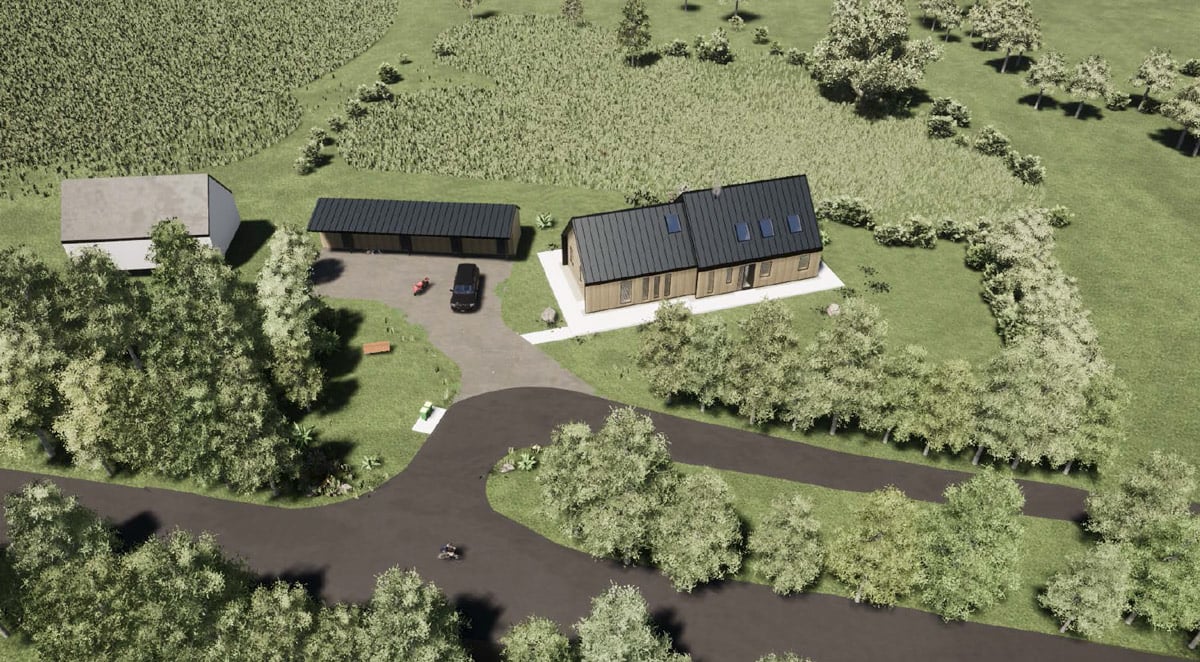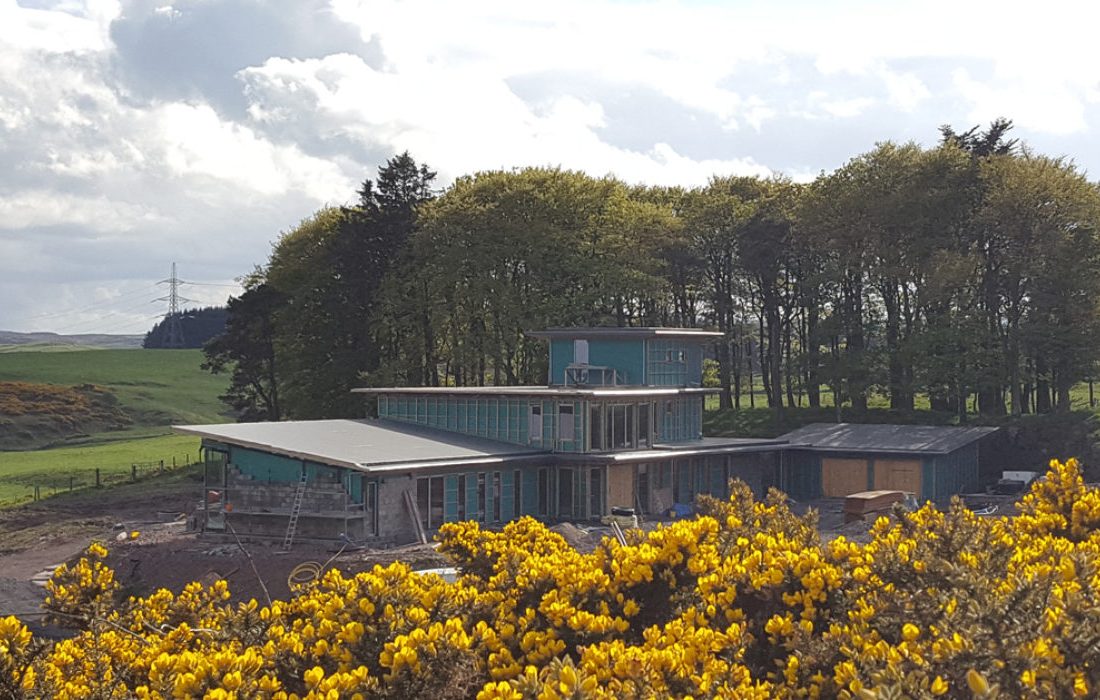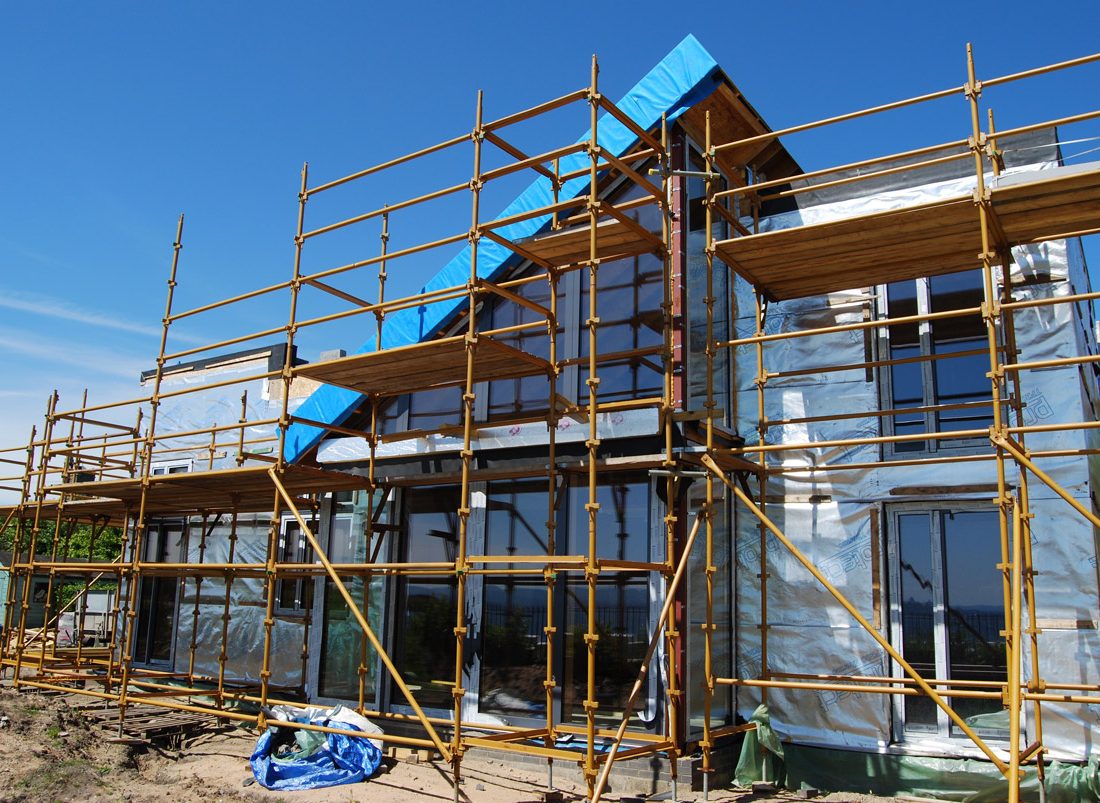You can find information about each of these concepts on our blog. Passive House is the strictest and in recent years, it has become increasingly popular among self-builders in the UK. We are happy to launch our Passive House Series where we will provide information on key aspects of this concept that will help you make up your mind if Passive House is for you.
A building designed to Passive House Standards will provide a number of benefits for its owners and/or tenants. Such benefits will include excellent indoor air quality with reduced internal pollutants and a constant supply of fresh air, a reduction in maintenance and running costs as well as a drastic reduction in energy consumption and CO² emissions.
There a number of initial design considerations that need to be taken in to account, these include but are not limited to; a compact building form, with minimum surface to volume ratios, to ensure a reduction in thermal bridging and heat loss, South facing orientation with large areas of glazing to maximise solar gains and provide a passive heat source for the building.
Additional considerations also include natural shading methods such as roof overhangs, free-standing balconies and deep window recesses to mention just a few. This article will look at a number of the main considerations and provide some introductory information to get the research and development stage of your project underway.

SITE FEATURES
External Landscape Features
The external landscape features for a chosen site would include all landscaping features that fall outwith the boundary of the site and largely outwith the control of the owner. These will range from large features such as mountains, hills, and high-rise buildings in the distance. Down to smaller features closer to the site boundary such as hills, trees and neighbouring buildings.
The main thing to be aware of with these features is anything that will affect the performance of the proposed building. The main issue will come from shading and/or reduced exposure to the sun resulting in less solar gains. Problems of this nature are not insurmountable, although anything that will have an impact on the potential performance should be assessed and considered accordingly.
Internal Landscape Features
Internal landscaping features of a chosen site describes all landscaping features within the boundary of the site that again may have an impact on the performance of a proposed building. These features will include hills, buildings or structures on the site, as well as tress and other shrubs and bushes.
Although these are within the boundary of the proposed plot the removal of these may still be beyond the control of the owner. It should be confirmed that any existing buildings are not listed and therefore cannot be removed. Similarly, with trees, it should be confirmed that there are not tree protection orders for the site that would prevent the removal of established trees.
SITE AND BUILDING ORIENTATION
Once a site assessment for internal and external landscaping features has been conducted, we can progress with the selection of a location for the proposed building. This, in part, will be done in conjunction with the assessment of the landscaping features as outlined above.
A Passive House should be aligned as due South as possible to allow for maximum collection of solar gains throughout both winter and summer. However, this is not always possible. The layout of the land may not be suitable, the best views on the land may be to the North, facing South may overlook a neighbouring property, there may be large landscaping features in the way…. so on and so forth.
This does not always have to mean that a site is not suitable for a Passive House project. Every site is different and many additional factors such as site location, altitude, and climate conditions will play a factor in performance. However, as a general rule, the further from South the building is orientated the more compensation will be required to achieve the desired performance. This compensation will come in the form of more insulation, a better air-tightness result and better performing windows and doors. The bottom line of all of this will mean higher costs for the finished building.

BUILDING FEATURES
Building Form
To simplify achieving Passive House certification the most straight forward approach is to design a building that has a compact form with minimum surface to volume ratios. This helps to minimise thermal bridging, makes achieving a good airtightness result easier and helps to reduce construction costs.
Every element of the building design that deviates from a compact form adds to the level of complexity, increases the amount of construction detailing that is required, increases the number of specialist materials that may be required and adds additional labour time to the project. All of these areas will reduce the likelihood of certification whilst increasing the costs of the building.
Construction Performance
The performance of key construction elements is crucial to the overall performance of the building and ultimately the ability of a building to achieve Passive House certification. The main elements of all building projects will include foundations, floor slab, external walls, roof, windows and doors.
The Passive House standard sets out minimum performance standards that must be met for all of the above elements in order to achieve certification. Whilst these represent one of the minimum requirements of certification it may not simply be enough to just meet these standards. The effect the performance of these elements will have on the overall performance of the building will also be impacted by the location of the site, the local climate and weather conditions of this area.
Maximum acceptable U-values for ground floor slab, external walls and roof areas is 0.15 W/m2a or better. However, as stated above this will not be enough for all projects. The further North you are in the UK the more improvements you will need to make to the U-values of these elements to achieve Passive House certification.
Maximum acceptable U-values for windows and doors is 0.8 W/m2a or better. Unlike above this U-value for windows and doors already represents a very high-performance product. Whilst it is possible to source windows and doors with a better U-value than this, these products can often be very expensive. It is therefore often more cost effective to achieve a higher performance building through additional insulation rather than windows and doors.
That said, Passive House performance can be a bit of a balancing act at times. Therefore, an improvement in one area may mean that you can relax other areas … slightly. The only way to know for sure is to assess the performance of the building within the Passive House Planning Package (PHPP) calculation. For now, just know there is some wiggle room.
Thermal Envelope
The thermal envelope comprises of all elements that will impact on the thermal performance of the building. These include the floor slab, external walls, roof, windows and doors. The thermal envelope of the building is the insulation layer that surrounds the entire building. Anywhere this insulation layer is broken such as windows and doors, a product with appropriate thermal performance should be used to eliminate the thermal bridge.
Areas of the thermal envelope where two or three components meet will require to be detailed and assessed for thermal bridging. Thermal bridging will occur in an area of the envelope where heat has the opportunity to travel from inside the building to the outside. This is generally around where components meet as timber and steel are generally used to tie the envelope together and provide structural support. Any areas where thermal bridging is detected should be detailed appropriately to remove the thermal bridge as far as possible.
Any other areas of the envelope that are penetrated by services of structure will also require to be assessed for any potential thermal bridging. As above any potential thermal bridging should be designed out of the project as far as possible.

Airtightness
Along with the thermal envelope, the building’s airtightness is very important for providing high levels of thermal performance and comfort. The airtightness result required for a certified Passive House 0.6 ac/h or below. This is 10 times more airtight than the maximum permitted result allowed with in Scottish regs and 15 times more airtight than the maximum permitted result allowed with the English regs. In short, a certified Passive House needs to be a very airtight building, so this area of the build needs to be given serious consideration.
The best way to determine the airtightness layer of the building is to look at the building in section. The airtightness layer is most commonly placed on the inside of the envelope. With a red marker draw a line all the way around the inside edge of the structural envelope. As with thermal bridging, anywhere there is a break in the envelope where two/three components meet is an area that will require specific detailing and attention to create an airtight envelope.
Airtightness can be achieved in various ways although this will all be determined by the construction used for the envelope of the building. The three main ways to achieve an airtight envelope are as follows:
1. Airtightness membranes and tapes, these are applied to the inside of the envelope. All joints are taped, with additional products used to provide an airtight seal around services and other penetrations.
2. The kit provides inherent airtightness, this could be an ICF system with a concrete core, a CLT solid timber system or a closed panel timber kit or SIPS kit with kit joints taped on the inside. As with the above method, additional products will be required to provide airtightness around services and other penetrations.
3. Liquid airtightness membrane, these products are similar to paint that can be brushed or sprayed on. They provide good coverage with minimal additional products required.
Costs for all methods and products noted above will vary depending on the size and complexity of the building. All buildings are different, and each project should be assessed to determine the most appropriate approach based on the design.

Windows and Doors
After the building envelope, the windows may well be the second most expensive cost on the project. These should therefore be given appropriate consideration. Passive house buildings in the UK will require the use of triple glazing to achieve certification. The thermal comfort levels required of these windows cannot be achieved with double glazing.
Maximum acceptable U-values for windows and doors is 0.8 W/m2a or better. There are a number of window and door manufacturers that can achieve this performance and beyond. It is important to make sure that products are compared on a like for like basis.
The main areas of windows and doors to focus on include the frame U-value, the glazing U-value, overall window U-value, spacer Psi value and number of integrated airtightness seals (most have at least 2, 3 is preferable if possible).
Other things be mindful of include, external finishes, frame materials, frame dimensions (most PH window frames are very large) are sills included or are these an extra cost.
Shading vs Overheating
This may come as a surprise to some people, but overheating is one of the most common issues experienced by Passive and low energy buildings in the UK. It is therefore very important to consider the provision of external shading on a Passive House and/or low energy building.
The type and amount of shading required will depend on the design of the building and the local climate. However, the types of shading that should be considered include, large roof overhangs, free standing balconies, deep window recesses, concealed roller shutters, exposed manual shutters, external blinds/louvres and a brise soleil.
MVHR and Services
Now that we have discussed the preparation of an airtight thermal envelope with minimal thermal bridging, we need to make sure that the building has an appropriate ventilation system. Passive House buildings require the use of a mechanical ventilation system with heat recovery (MVHR).
The MVHR is a balanced system. The crossflow heat exchanges allow the system to provide a constant stream of fresh air which has been prewarmed with heat from the extracted air. As the air streams never mix, the heat is transferred without any transferal of smells. Silencers are used from the unit and between rooms to prevent cross talk and the system can be boosted to remove excess humidity after showers or cooking.
The MVHR system will be specified based on the project size and design. However, a few things to know when selecting an appropriate system are as follows: the MVHR should have a good heat recovery efficiency (80% and above would represent good system performance), The performance of the system should be verified through Passive House Institute accreditation (or tested to an equivalent standard).
Other considerations include: the unit should be placed against an external wall so that the intake and exhaust ducts have as small runs as possible, the unit should be easily accessible to allow for maintenance and filter changes, space will be required around the system to remove covers to change filters, some units have a condensate drain this will need connected to drainage, defrost units and post heaters can be added to the system to help boost performance.

Although the MVHR system will recover solar gains and other sources of heat within the envelope, this system should not be considered a heating system. A separate heating system should always be specified for any Passive House building.
Most heating systems will be suitable for Passive house buildings providing the heating system is sized based on the heating load for the building. As mentioned previously the PHPP calculation will provide an accurate heating load for the building based on the design and specification.
If a wood burning stove is to be used as a means of heating the building, it is important to be aware that due to a Passive House buildings high specification and low heating load requirement, the stove will need to be sized appropriately. It can often be difficult to get wood burning stoves with a low enough output for a Passive or low energy building. A general suggestion would be that a 2-3kW unit would be more than adequate to service the needs of a Passive House building dependant on size, design and specification.
Please also note, any unit specified for a Passive House building will also need to use a balanced flue with no combustion air taken from within the building. This is for safety reasons based on the extremely airtight construction.
Have you read other articles from our Passive House Series? You can find them below:
Making the decision to build a Passive House or an extremely low energy house should not be taken lightly. However, based on the current energy crisis, climate change and the poor economy status over the past few years, building to this standard to save energy and guarantee comfort levels quickly becomes a very easy decision to make.
The information provided in this article is intended as a stepping off point for more research and investigation into the various elements that come together to create a certified Passive House. Further information will follow in future articles with a number of the topics discussed here expanded on a looked at in more detail.
This article is a part of Passive House Series where we describe various areas of building a home to achieve this certification. If you want to learn more about our Passive House design offer, visit our services page.




